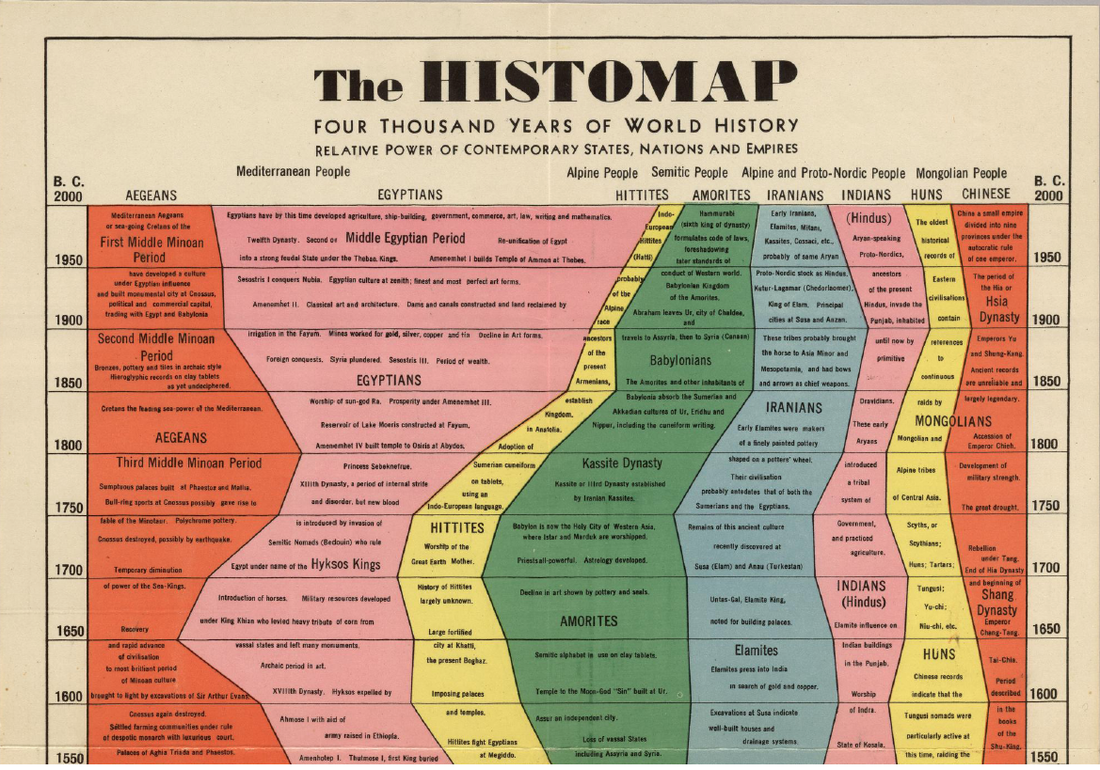|
THE HISTOMAP is the first historical map I have found which presents 4000 years of history and the relationships between populations at a glance! Below are just a few ideas, vocabulary and expressions to ask questions with: - Prepare questions using: How long...? Which... ? When... ? Where... ? Who... ? etc. - Comparisons. ' - more powerful than - the most powerful - as... as - New vocabulary, verbs, passive tense and collocations: - conquered (by) - reign lasted - were in power for - lasted - weak / strong - great - destroyed (by) - short-lived - long-lived - Western / Eastern world - Middle-East - developed - grew - maintained - people vs population You can download THE HISTOMAP below. I found it freely downloadable in Internet .. Hope you find some stimulating questions to ask with it! Susan If you have NO TIME to STUDY but want to improve your English in 10 minutes a day, while you are DRIVING TO WORK or MAKING DINNER, check out LEARN ENGLISH NATURALLY with GUIDED FLUENCY & LISTENING PRACTICE ONLY 10 minutes a day take you a very long way… http://bilingual-communications.weebly.com/store/c1/Featured_Products.html Also check out MY PLAYLIST for more of Susan's ESL Learning Videos (Chants & Songs) https://www.youtube.com/playlist?list=PLrvV_PywFOlxgfR5RpMw7rLsI6ai3yHai
0 Comments
A REAL BARGAIN is an amusing unit on the PASSIVE TENSE taken from Streamline English Departures (Hartley & Viney, OUP 1983) – my absolute favourite not only for teaching the passive tense but particulary for imparting a culture lesson on Houses in Great Britain. With its beautiful illustrations, rich housing vocabulary and amusing content – it makes a fun lesson on British culture. I usually ask students to read the text taking turns to be the Estate Agent and Mr. Palmer, the prospective buyer, stopping after each paragraph to explain the vocabulary and the passive tense as it develops:
As they read the story I ask very easy listening comprehension questions, paragraph by paragraph, which they do not have so they have to understand them and reread the paragraph to reply. I only explain the vocabulary and cultural habits we have as the story enfolds since I do not want to spoil the amusing ending to the story. Since I believe in full-immersion, I do not translate the vocabulary but define and illustrate on the board. This is also an opportunity for students to compare their homes and cultural housing traditions to the British ones – an opportunity for class discussion. VOCABULARY Estate Agent semi-detached house detached house cottage bungalow block of flats terraced house town house owners roof tiled roof thatched roof flat roof electrical wiring rewired redecorated (wallpaper is very common) wallpaper repainted central heating (as opposed to the old fireplace with the mantelpiece) brick stone services: - dustbins emptied - post delivered - milk delivered (the milkman with his silent electric van early in the morning) motorway It was only when a friend of mine came to visit my home in Italy that he opened my eyes to differences I had never considered: “Wow! You have real marble windowsills!” – British windowsills are made of wood which need to be constantly repainted to stop them from rotting. “You have beautiful wooden doors!” British doors are usually just painted over. “Your floors are solid marble or parquet!” British floors are loose floorboards with some kind of covering: carpet, lino… Any other main differences your students may have noticed watching films? Mine pointed out that in the USA and GB the kitchen sink is always in front of a window – true but I had never noticed. You can download the materials below. I hope you find this activity as useful and enjoyable as I do. Susan
In constant search for stimulating materials to use with my wide age and level range of students a couple of months ago I stumbled upon THE HISTOMAP which then got lost in my jungle of digital files buried in my computer. It casually reappeared on my screen at the end of the school year and I felt the urge to print and laminate it, sticking it's colourful seven-page vertical length on a column in front of my main entrance door where it is always met with curiosity and fascination. It is the first historical map in my possession which presents 4000 years of history and the relationships between populations in an immediately decipherable context. I have finally come to understand history at a glance! The other day it occurred to me what a potential THE HISTOMAP has for CLIL history lessons but not only... below are just a few ideas which came to mind: - Groups of students prepare questions for other groups using: How long...? Which... ? When... ? - Comparisons can be made: - more powerful than - the most powerful - as... as - New vocabulary, verbs, passive tense and collocations can be introduced: - conquered (by) - reign lasted - were in power for - lasted - weak / strong - great - destroyed (by) - short-lived - long-lived - Western / Eastern world - Middle-East - developed - grew - maintained - people vs population - RESEARCH PROJECTS can be given to youngsters to then present to everyone - ADULTS can tell us anything they know about the various historical periods or populations from personal knowledge. Any other ideas?? You can download THE HISTOMAP below. I found it freely downloadable in Internet .. Hope you find some more stimulating activities to do with it! Susan
|
Categories
All
Would you like regular English learning & teaching ideas? Subscribe to my blog so you don't miss a post!
AuthorMy name is Susan Brodar, born in London into a multilingual family and brought up bilingual English / Italian. Archives
December 2018
|
||||||||||||||||||||||||||||||||||||||||||||||








 RSS Feed
RSS Feed





